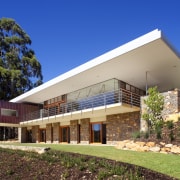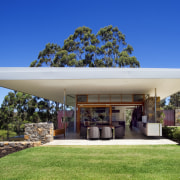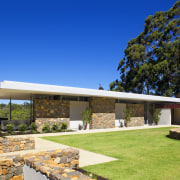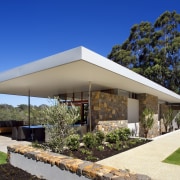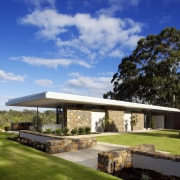Commanding perspective - Innovative glass holiday home by Wright Feldhusen Architects
Innovative glass holiday home by Wright Feldhusen Architects
It is said that opposites attract think smooth versus textured, light versus dark and solid versus ephemeral. The yin and yang of such elements has long been recognised as a way to achieve harmony, and so it is with the house shown here.
In designing the holiday home for an extended family, architect Tim Wright of Wright Feldhusen Architects used a variety of contrasting materials and textures to provide a contemporary architectural response to the landscape.
"This is a rural site that not only offers extensive river valley views, but also looks out to vineyards and an avocado farm," Wright says. "The most spectacular views are to the east. We could see the site was most conducive to a house with a stone base and a floating glass pavilion on top. The base would accommodate most of the bedrooms, while the glass pavilion would house the main living areas."
Wright says the architecture was also influenced by the owners' involvement in steel fabrication and engineering design.
"Because the house was to be built from steel, there was an opportunity to provide a more dynamic roof form that we might otherwise have been able to do."
The house is consequently defined by its large roof that appears suspended above the glass walls of the main living area. The sheer size of the roof provides extensive overhangs that screen the sun and reinforce the sense of the house hovering above the valley.
Wright also introduced stone to the upper level. Alternating panels of white-painted rendered concrete feature on the west-facing facade, helping to reduce the heat load from the sun in the afternoon. The same materials appear on low walls in the landscape designed by Paul Bangay.
"I was most interested in materials that are robust and don't need a lot of maintenance," the architect says. "I like materials that weather and gain a patina with age. For this reason, also, copper clads a box-like form that appears to penetrate the house, from front to back. Over time, the copper will fade and form an attractive green verdigris."
On the east side of the house, the copper box, which accommodates the master suite, is cantilevered out from the house, providing even more visual drama.
Similar materials appear inside the main living area. The copper, for example, reappears at the back of the kitchen, maintaining the visual axis of the penetrating box element. The stone and white-painted rendered concrete of the west facade are also exposed on the interior, where one of the stone walls forms a chimney.

The remaining walls in the living area are glazed with butt-jointed glass that enhances the pavilion look. A suspended Flos light and spider fixings, which brace the 3.8m-high glass to accommodate the wind load, also bring an architectural feel to the interior.
"The transparency of the main living area is critical to swallowing the view," says Wright. "The stairwell on the south side is also glazed to capture a view of towering gum trees and to allow light into this side of the house. Cross ventilation is provided by high window louvres."
Light is introduced to bedrooms on the lower levels, through full-height glass doors and ground-level glazing beside the exterior walls above.
In addition to three bedrooms on the lower level, there is a second family living room. Wright says the design and the stone base provide good acoustic insulation between the two floors and allow a comfortable sense of intimacy.
Credit list
Builder
Landscape construction
Flooring
Benchtops
Rangehood
Landscaping design
Cladding
Paints
Cabinetry
Wall oven, cooktop and dishwasher
Story by: Colleen Hawkes
Home kitchen bathroom commercial design
Personality plus
Diving into nature
Classic looks, contemporary efficiency

